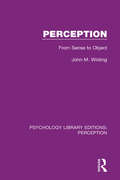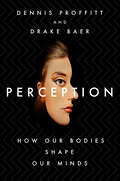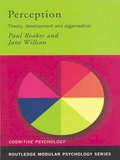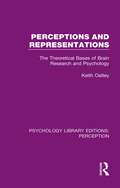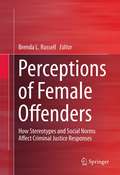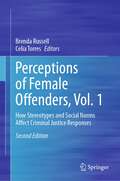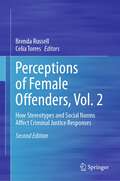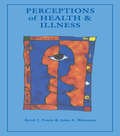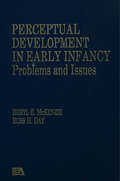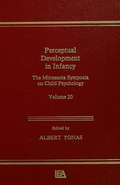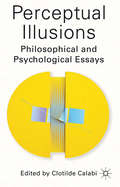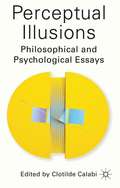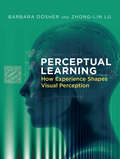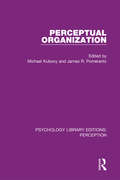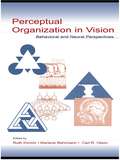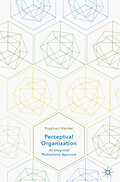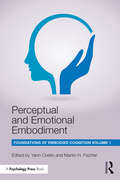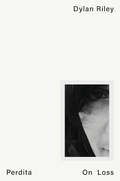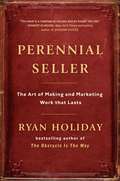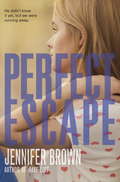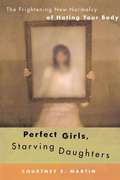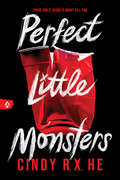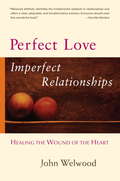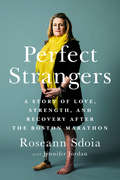- Table View
- List View
Perception: From Sense to Object (Psychology Library Editions: Perception #34)
by John M. WildingOriginally published in 1982, this book introduces the student to the central problem of all perceptual theories: just how does the perceiver identify particular objects? In focusing on the problem, Dr Wilding provides a coherent, well organized framework for its study, bypassing the conventional split between perception and reaction time evidence which was common to most textbooks at the time. The author draws on evidence from a wider number of research traditions and argues that each has a contribution to make to any account of perception. Throughout he emphasizes the methodological basis of the research discussed, in order to provide students with a solid foundation for their own practical work.
Perception: How Our Bodies Shape Our Minds
by Dennis Proffitt Drake BaerA groundbreaking popular psychology book that explores the deep connection between our body and our brain.Over decades of study, University of Virginia psychologist Dennis Proffitt has shown that we are each living our own personal version of Gulliver’s Travels, where the size and shape of the things we see are scaled to the size of our bodies, and our ability to interact with them. Stairs look less steep as dieters lose weight, baseballs grow bigger the better players hit, hills look less daunting if you’re standing next to a close friend, and learning happens faster when you can talk with your hands.Written with journalist Drake Baer, Perception marries academic rigor with mainstream accessibility. The research presented and the personalities profiled will show what it means to not only have, but be, your unique human body. The positive ramifications of viewing ourselves from this embodied perspective include greater athletic, academic, and professional achievement, more nourishing relationships, and greater personal well-being. The better we can understand what our bodies are—what they excel at, what they need, what they must avoid—the better we can live our lives.
Perception: Theory, Development and Organisation (Routledge Modular Psychology)
by Paul Rookes Jane WillsonPaul Rookes and Jane Willson explain perception and perceptual processes in a way that almost anyone can understand. The study of perception, or how the brain processes information from the senses , has fascinated psychologists and philosophers for a long time. Perception takes the key research areas and presents the arguments and findings in a clear, concise form, enabling the reader to have a quick working knowledge of the area.This clear and informative text discusses sensation and perception then looks at theories and explanations of perception. The way visual perception is structured is examined, followed by an analysis of the development of perceptual processes. The authors then consider individual social and cultural variations in perceptual organisation. Perception will be particularly useful to students new to higher-level study. With its helpful textbook features to assist in examination and learning techniques, it should interest all introductory psychology students.
Perceptions and Representations: The Theoretical Bases of Brain Research and Psychology (Psychology Library Editions: Perception #24)
by Keith OatleyOriginally published in 1978, this study examines the shortcomings of some theoretical approaches to psychological and neurophysiological mechanisms at the time. Keith Oatley illustrates the extent of these shortcomings by showing how inefficient brain researchers – using their present approaches – would be in trying to understand a computer, which is considerably simpler than the human brain. He concludes that we need better theories than those usually espoused in psychology, and goes on to expound a theory of cognitive representation and inference in perception, which began with Helmholtz more than a hundred years ago but which can now be given substance and formal structure in artificial intelligence programs. The author deploys this theory to give an account of some fundamental problems, such as how we see a three-dimensional world, and how the brain copes so well with incomplete sensory data and with damage to its own components.
Perceptions of Female Offenders
by Brenda RussellFemale offenders are often perceived as victims who commit crimes as a self-defense mechanism or as criminal deviants whose actions strayed from typical 'womanly' behavior. Such cultural norms for violence exist in our gendered society and there has been scholarly debate about how male and female offenders are perceived and how this perception leads to differential treatment in the criminal justice system. This debate is primarily based upon theories associated with stereotypes and social norms and how these prescriptive norms can influence both public and criminal justice response. Scholars in psychology, sociology, and criminology have found that female offenders are perceived differently than male offenders and this ultimately leads to differential treatment in the criminal justice system. This interdisciplinary book provides an evidence based approach of how female offenders are perceived in society and how this translates to differential treatment within the criminal justice system and explores the ramifications of such differences. Quite often perceptions of female offenders are at odds with research findings. This book will provide a comprehensive evidence-based review of the research that is valuable to laypersons, researchers, practitioners, advocates, treatment providers, lawyers, judges, and anyone interested in equality in the criminal justice system.
Perceptions of Female Offenders, Vol. 1: How Stereotypes and Social Norms Affect Criminal Justice Responses
by Brenda Russell Celia TorresThis first volume of the second edition builds on the many developments made to the study of female offenders, compiling new insights and evidence-based research. With new cases such as Amber Heard and Johnny Depp, it further explores topics including the role of social media in how female offenders are portrayed, juvenile offenders, female aggression in young adults, female perpetrators of domestic violence and more. This book begins with new research on gender stereotypes, disruptive behavior, female aggression, the impact of American media and culture, and gender stereotypes and how they relate to female offending. It examines more diverse topics to include greater intersectionality of female perpetrators in terms of age, race, ethnicity, and sexual identity, and country. Additionally, it provides a comprehensive evidence-based review of the research that is valuable to researchers, practitioners, and advocates interested in equality in the criminal justice system.
Perceptions of Female Offenders, Vol. 2: How Stereotypes and Social Norms Affect Criminal Justice Responses
by Brenda Russell Celia TorresThis new edition is a nuanced exploration of female involvement in various crimes—from delinquency, domestic violence, sexual assault and homicide—that resonates with the pulse of contemporary society. In an age where many events are tweeted and debated online, this book delves into the intricate ways social media portrays female offenders and how this can distort public perceptions and effect legal outcomes. Volume two includes recent research and theory examining how female perpetration is intricately related to gender roles that persist within the criminal justice system and often lead to gender disparities in treatment, criminal justice response, and sentencing and calls into question long-held beliefs and systems that might not be as impartial as they appear. The compelling nature of this volume addresses the complex relationship between trauma and offending and examines crucial subjects like partner violence homicide and the unique challenges faced by trans-women within the criminal justice system, and examines the myths associated with female offending and how that bleeds into criminal justice response. It addresses theories that provide insight into female offending and sentencing and offers ways to generate gender inclusiveness. This volume invites researchers, practitioners, and advocates for justice to join a vital conversation and develop a more informed and equitable criminal justice response.
Perceptions of Health and Illness: Current Research And Applications
by Keith J. Petrie John A. WeinmanFirst Published in 1997. The study of how individuals perceive and make sense of health and illness is a new and rapidly developing area in health psychology. The field has seen important recent theoretical developments and applications to a wide range of health threats and illnesses. The first section of this book examines the current theoretical and measurement issues in the field and includes issues related to illness perceptions across the lifespan, disability, and the assessment of illness representations in chronic illness. The second section addresses the role of illness perceptions in health screening and prevention and includes work on perceptions of genetic disease, cancer screening, and how individuals process health risk information. The third section is concerned with the application of the illness perceptions approach to patients with chronic illness and those undergoing treatment. Illnesses examined using this approach include chronic fatigue syndrome, breast cancer, diabetes, and myocardial infarction.
Perceptual Development in Early Infancy: Problems & Issues
by Ross H. Day Beryl E. McKenzieFirst published in 1987. This book is not intended to be either a comprehensive reference work or a systematic handbook on perception in infancy. Nor is it another published report of a recently held conference. It is a collection of state-of-the-art essays on perception during the first year or so of infant development. Rather than first choosing the topics and then finding experts to write about them the editors first chose the experts and invited them to write about those topics in which we know them to be interested and closely involved. The outcome of this approach is a collection of chapters in which the authors at the same time critically review earlier contributions to the topic, report their own work, identify numerous unresolved problems and key issues, and point out directions for future inquiry. Naturally the emphasis placed on these facets varies markedly with both topic and author. The result is a collection of commentaries that we believe to be comprehensive, informative, interesting, and provocative.
Perceptual Development in infancy: The Minnesota Symposia on Child Psychology, Volume 20 (Minnesota Symposia on Child Psychology Series)
by Albert YonasEach year, the Institute of Child Development brings together a group of distinguished investigators who share a common desire to understand the nature of development. The chapters in this volume are based on papers presented at the 20th of this continuing series, the Minnesota Symposia on Child Psychology. The meetings were held October 31 through November 2, 1985, at the University of Minnesota.
Perceptual Illusions: Philosophical and Psychological Essays
by C. CalabiAlthough current debates in epistemology and philosophy of mind show a renewed interest in perceptual illusions, there is no systematic work in the philosophy of perception and in the psychology of perception with respect to the concept of illusion and the relation between illusion and error. This book aims to fill that gap.
Perceptual Illusions: Philosophical and Psychological Essays
by Clotilde CalabiAlthough current debates in epistemology and philosophy of mind show a renewed interest in perceptual illusions, there is no systematic work in the philosophy of perception and in the psychology of perception with respect to the concept of illusion and the relation between illusion and error. This book aims to fill that gap.
Perceptual Intelligence: The Brain's Secret to Seeing Past Illusion, Misperception, and Self-Deception
by Montel Williams Brian Boxer WachlerThe Secret Behind Our Perceptions Finally Revealed!Why do we gravitate to products endorsed by celebrities? Why does time seem to go by faster as we get older? Why are some athletes perpetual winners and others losers? Exploring the brain’s ability to interpret and make sense of the world, Dr. Brian Boxer Wachler describes how your perception can be reality or fantasy and how to separate the two, which is the basis of improving your Perceptual Intelligence (PI). With concrete examples and case studies, Dr. Brian (as he’s known to his patients) explains why our senses do not always match reality and how we can influence the world around us through perceptions, inward and outward. By fine-tuning your PI, you can better understand what’s really going on and make more insightful decisions in your life.
Perceptual Learning: How Experience Shapes Visual Perception
by Zhong-Lin Lu Barbara DosherA comprehensive and integrated introduction to the phenomena and theories of perceptual learning, focusing on the visual domain.Practice or training in perceptual tasks improves the quality of perceptual performance, often by a substantial amount. This improvement is called perceptual learning (in contrast to learning in the cognitive or motor domains), and it has become an active area of research of both theoretical and practical significance. This book offers a comprehensive introduction to the phenomena and theories of perceptual learning, focusing on the visual domain.
Perceptual Organization (Psychology Library Editions: Perception #16)
by Michael Kubovy James R. PomerantzOriginally published in 1981, perceptual organization had been synonymous with Gestalt psychology, and Gestalt psychology had fallen into disrepute. In the heyday of Behaviorism, the few cognitive psychologists of the time pursued Gestalt phenomena. But in 1981, Cognitive Psychology was married to Information Processing. (Some would say that it was a marriage of convenience.) After the wedding, Cognitive Psychology had come to look like a theoretically wrinkled Behaviorism; very few of the mainstream topics of Cognitive Psychology made explicit contact with Gestalt phenomena. In the background, Cognition's first love – Gestalt – was pining to regain favor. The cognitive psychologists' desire for a phenomenological and intellectual interaction with Gestalt psychology did not manifest itself in their publications, but it did surface often enough at the Psychonomic Society meeting in 1976 for them to remark upon it in one of their conversations. This book, then, is the product of the editors’ curiosity about the status of ideas at the time, first proposed by Gestalt psychologists. For two days in November 1977, they held an exhilarating symposium that was attended by some 20 people, not all of whom are represented in this volume. At the end of our symposium it was agreed that they would try, in contributions to this volume, to convey the speculative and metatheoretical ground of their research in addition to the solid data and carefully wrought theories that are the figure of their research.
Perceptual Organization in Vision: Behavioral and Neural Perspectives (Carnegie Mellon Symposia on Cognition)
by Marlene Behrmann Ruth Kimchi Carl R. OlsonThis book presents an overview of different frameworks for understanding perceptual organization, and a state-of-the-art summary of the domain. It describes findings from visual search, illusory contours, and object recognition using electrophysiological measures.
Perceptual Organization: An Integrated Multisensory Approach
by Stephen HandelThis textbook goes beyond introductory sensory perception by incorporating supplementary electronic materials to demonstrate the parallels between both hearing and seeing. Each chapter intermixes seeing and hearing processes so that students can easily understand that perceptual organization is the same across different kinds of sensations and modalities. Figures illustrating visual organization are paired with sound files demonstrating the analogous auditory organization. While most books on sensation and/or perception treat the senses individually there is growing awareness of just how important multisensory integration is to understanding the connection between sensory perception and cognition.
Perceptual and Emotional Embodiment: Foundations of Embodied Cognition Volume 1
by Martin H. Fischer Yann CoelloThis two-volume set provides a comprehensive overview of the multidisciplinary field of Embodied Cognition. With contributions from internationally acknowledged researchers from a variety of fields, Foundations of Embodied Cognition reveals how intelligent behaviour emerges from the interplay between brain, body and environment. Covering early research and emerging trends in embodied cognition, Volume 1 Perceptual and Emotional Embodiment is divided into four distinct parts, bringing together a number of influential perspectives and new ideas. Part one opens the volume with an overview of theoretical perspectives and the neural basis of embodiment, before part two considers body representation and its links with action. Part three examines how actions constrain perception of the environment, and part four explores how emotions can be shaped and structured by the body and its activity. Building on the idea that knowledge acquisition, retention and retrieval are intimately interconnected with sensory and motor processes, Foundations of Embodied Cognition is a landmark publication in the field. It will be of great interest to researchers and advanced students from across the cognitive sciences, including those specialising in psychology, neuroscience, intelligent systems and robotics, philosophy, linguistics and anthropology.
Perdita: On Loss
by Dylan RileyAn intense literary memoir of love and grief&“Our marriage was, from any conventional point of view, wildly implausible; and you, my dear son, are the miraculous product of this beautiful, rather crazy, and all too brief love affair.&” When Dylan Riley received the devastating news that his wife, Emanuela, had cancer, he turned to writing to express the anguish and disarray brought by her worsening symptoms and then her passing. Perdita, composed for their teenage son, Eamon, is the result of this attempt to represent loss. It is at once a portrait of youth, a lyrical memoir of a marriage, and a raw and moving account of bereavement.Riley describes cancer, Perdita&’s central antagonist, as a pitiless opponent, draining hope of its power and reducing it to self-delusion. Its course forces a progressive foreshortening of time. Next year might be terrible, but there can be a few good months now; tomorrow will likely be bad, but let&’s focus on today.In this memoir, the disease provokes a broader set of reflections on the openness, contingency, and pain of the human condition, a status defined by the context of mortality, both our own and that of those we love.
Perennial Seller: The Art of Making and Marketing Work that Lasts
by Ryan HolidayHow did the movie The Shawshank Redemption fail at the box office but go on to gross more than $100 million as a cult classic? How did The 48 Laws of Power miss the bestseller lists for more than a decade and still sell more than a million copies?How is Iron Maiden still filling stadiums worldwide without radio or TV exposure forty years after the band was founded?Bestselling author and marketer Ryan Holiday calls such works and artists perennial sellers. How do they endure and thrive while most books, movies, songs, video games, and pieces of art disappear quickly after initial success? How can we create and market creative works that achieve longevity?Holiday explores this mystery by drawing on his extensive experience working with businesses and creators such as Google, American Apparel, and the author John Grisham, as well as his interviews with the minds behind some of the greatest perennial sellers of our time. His fascinating examples include:• Rick Rubin, producer for Adele, Jay-Z, and the Red Hot Chili Peppers, who teaches his artists to push past short-term thinking and root their work in long-term inspiration.• Tim Ferriss, whose books have sold millions of copies, in part because he rigorously tests every element of his work to see what generates the strongest response.• Seinfeld, which managed to capture both the essence of the nineties and timeless themes to become a modern classic.• Harper Lee, who transformed a muddled manuscript into To Kill a Mockingbird with the help of the right editor and feedback.• Winston Churchill, Stefan Zweig, and Lady Gaga, who each learned the essential tenets of building a platform of loyal, dedicated supporters.Holiday reveals that the key to success for many perennial sellers is that their creators don’t distinguish between the making and the marketing. The product’s purpose and audience are in the creator’s mind from day one. By thinking holistically about the relationship between their audience and their work, creators of all kinds improve the chances that their offerings will stand the test of time.
Perfect Escape
by Jennifer BrownKendra has always felt overshadowed by her older brother, Grayson, whose OCD forces him to live a life of carefully coordinated routines. The only way Kendra can stand out next to Grayson is to be perfect, and she has perfection down to an art -- until a cheating scandal threatens her flawless reputation.Behind the wheel of her car, with Grayson asleep beside her, Kendra decides to drive away from it all -- with enough distance, maybe she'll be able to figure everything out. But even in the midst of the road trip's flat tires, gas-station food stops, and detours to quirky roadside attractions, eventually Kendra must stop running and come to terms with herself, her brother, and her past.With undeniable grace and humor, acclaimed author Jennifer Brown explores OCD, the pressure for perfection, and the emotional highs and lows of a complex sibling relationship.
Perfect Girls, Starving Daughters: The Frightening New Normalcy of Hating Your Body
by Courtney E. Martin"Why does every one of my friends have an eating disorder, or, at the very least, a screwed-up approach to food and fitness?" writes journalist Courtney E. Martin. The new world culture of eating disorders and food and body issues affects virtually all -- not just a rare few -- of today's young women. They are your sisters, friends, and colleagues -- a generation told that they could "be anything," who instead heard that they had to "be everything." Driven by a relentless quest for perfection, they are on the verge of a breakdown, exhausted from overexercising, binging, purging, and depriving themselves to attain an unhealthy ideal. An emerging new talent, Courtney E. Martin is the voice of a young generation so obsessed with being thin that their consciousness is always focused inward, to the detriment of their careers and relationships. Health and wellness, joy and love have come to seem ancillary compared to the desire for a perfect body. Even though eating disorders first became generally known about twenty-five years ago, they have burgeoned, worsened, become more difficult to treat and more fatal (50 percent of anorexics who do not respond to treatment die within ten years). Consider these statistics: Ten million Americans suffer from eating disorders. Seventy million people worldwide suffer from eating disorders. More than half of American women between the ages of eighteen and twenty-five would prefer to be run over by a truck or die young than be fat. More than two-thirds would rather be mean or stupid. Eating disorders have the highest mortality rate of any psychological disease. In Perfect Girls, Starving Daughters, Martin offers original research from the front lines of the eating disorders battlefield. Drawn from more than a hundred interviews with sufferers, psychologists, nutritionists, sociocultural experts, and others, her exposé reveals a new generation of "perfect girls" who are obsessive-compulsive, overachieving, and self-sacrificing in multiple -- and often dangerous -- new ways. Young women are "told over and over again," Martin notes, "that we can be anything. But in those affirmations, assurances, and assertions was a concealed pressure, an unintended message: You are special. You are worth something. But you need to be perfect to live up to that specialness." With its vivid and often heartbreaking personal stories, Perfect Girls, Starving Daughters has the power both to shock and to educate. It is a true call to action and cannot be missed.
Perfect Little Monsters
by Cindy R. HeSomeone has murdered the queen bee of Sierton High School. All the dead girl's friends are suspects. And each one has a reason for wanting her to die.Ella Moore was the most popular girl in school…and also the most hated. When she's murdered at her own party, there are too many suspects to count. And too many people who think she deserved it.The police's prime suspect is the new girl, Dawn Foster. Dawn was the last to hand Ella a drink on the night she died. Plus, all of Ella's friends with a motive for wanting Ella dead are more than willing to throw Dawn under the bus, if it means keeping the heat off themselves. But Dawn refuses to go down without a fight. She's determined to clear her name. As she delves deeper into the past, she discovers that Ella and her friends had major enemies, and someone is out for revenge. Dawn must uncover the truth before the police arrest the wrong suspect… and before the next person dies.
Perfect Love, Imperfect Relationships: Healing the Wound of the Heart
by John WelwoodWhile most of us have moments of loving freely and openly, it is often hard to sustain this where it matters most--in our intimate relationships. Why if love is so great and powerful are human relationships so challenging and difficult? If love is the source of happiness and joy, why is it so hard to open to it fully and let it govern our lives? In this book, John Welwood addresses these questions and shows us how to overcome the most fundamental obstacle that keeps us from experiencing love's full flowering in our lives.Perfect Love, Imperfect Relationships begins by showing how all our relational problems arise out of a universal, core wounding around love that affects not only our personal relationships but the quality of life in our world as a whole. This wounding shows up as a pervasive mood of unlove--a deep sense that we are not intrinsically lovable just as we are. And this shuts down our capacity to trust, so that even though we may hunger for love, we have difficulty opening to it and letting it circulate freely through us.This book takes the reader on a powerful journey of healing and transformation that involves learning to embrace our humanness and appreciate the imperfections of our relationships as trail-markers along the path to great love. It sets forth a process for releasing deep-seated grievances we hold against others for not loving us better and against ourselves for not being better loved. And it shows how our longing to be loved can magnetize the great love that will free us from looking to others to find ourselves.Written with penetrating realism and a fresh, lyrical style that honors the subtlety and richness of our relationship to love itself, this revolutionary book offers profound and practical guidance for healing our lives as well as our embattled world.
Perfect Strangers: Friendship, Strength, and Recovery After Boston's Worst Day
by Jennifer Jordan Roseann SdoiaFour lives brought together in a deadly moment prove that being in the wrong place at the worst time can lead to life's biggest adventures and most important relationshipsAs Roseann Sdoia waited to watch her friend cross the finish line of the Boston Marathon in 2013, she had no idea her life was about to change-that in a matter of minutes she would look up from the sidewalk, burned and deaf, staring at her detached foot, screaming for help amid the smoke and blood.In the chaos of the minutes that followed, three people would enter Roseann's life and change it forever. The first was Shores Salter, a college student who, when the bomb went off, instinctively ran into the smoke while his friends ran away. He found Roseann lying on the sidewalk and, using a belt as a tourniquet, literally saved her life that day. Then, Boston police officer Shana Cottone arrived on the scene and began screaming desperately at passing ambulances, all full, before finally commandeering an empty paddy wagon. Just then a giant appeared, in the form of Boston firefighter Mike Materia, who carefully lifted her into the fetid paddy wagon. He climbed in and held her burned hand all the way to the hospital. Since that day, he hasn't left her side, and today they are planning their life together.Perfect Strangers is about recovery, about choosing joy and human connection over anger and resentment, and most of all, it's about an unlikely but enduring friendship that grew out of the tragedy of Boston's worst day.
